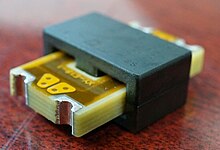Planar transformer
This article may lend undue weight to certain ideas, incidents, or controversies. (January 2014) |


Planar transformers are devices used to exact standards with precise electrical characteristics such as capacitance, output, and aspect ratio.[1] They are used in military and aerospace projects.
Planar transformers[2] are high frequency transformers used in isolated switchmode power supplies operating at high frequency. As opposed to conventional "wire-wound-on-a-bobbin" transformers, planar transformers usually contain winding turns made of thin copper sheets riveted together at the ends of turns in the case of high current windings, or windings etched on a PCB in a spiral form. As the current conductors are thin sheets of copper, the operating frequency is not limited by skin effect. As such, high power converters built with planar transformers can be designed to operate at relatively high switching frequencies, often 100 kHz or above. This reduces the size of required magnetic components and capacitors, thereby increasing power density.
Advantages over conventional counterparts
[edit]- High power density
- Significantly reduced height (low profile)
- Greater surface area, resulting in improved heat dissipation capability
- Greater magnetic cross-section area, enabling fewer turns
- Smaller winding area
- Winding structure facilitates interleaving
- Lower leakage inductance resulting from fewer turns and interleaved windings
- Less AC winding resistance
- Excellent reproducibility, enabled by winding structure[3]
References
[edit]- ^ "Planar Transformers". Standex Meder. Retrieved December 6, 2013.
- ^ "What is Planar Technology?, Planar Technology".
- ^ Dixon, Lloyd. "Designing Planar Magnetics" (PDF). Texas instruments. Retrieved December 6, 2013.

